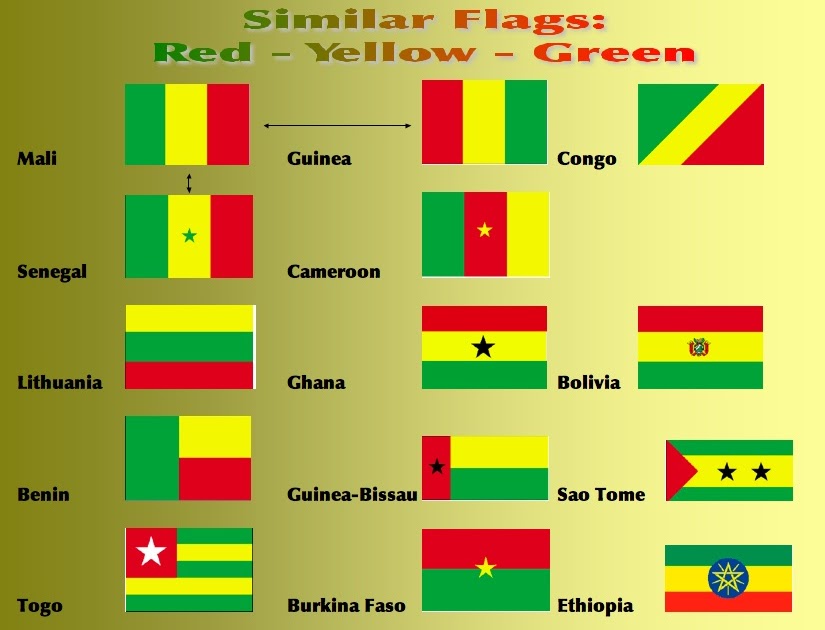When it comes to the vibrant world of national flags, the colors red, yellow, and green hold significant meaning and representation. These colors often symbolize the cultural identity, history, and values of nations. In this article, we will delve into the importance of these colors in flags, explore various countries that feature them, and understand what each flag represents. By the end of this article, you will gain a deeper appreciation for the flags that adorn our global landscape.
The use of red, yellow, and green in flags is not merely a design choice; it is deeply rooted in the historical and cultural narratives of each nation. These colors can represent struggles for freedom, the richness of resources, and the unity of people. As we navigate through this topic, we will identify countries whose flags prominently feature these colors and the stories behind them.
In addition to exploring individual flags, we will discuss the symbolism associated with each color. Understanding what red, yellow, and green signify can provide insight into the values that nations hold dear. So, let’s embark on this colorful journey through the world of country flags.
Table of Contents
- 1. The Significance of Colors in Flags
- 2. Countries with Red, Yellow, and Green Flags
- 3. Symbolism of Red in Flags
- 4. Symbolism of Yellow in Flags
- 5. Symbolism of Green in Flags
- 6. Notable Flags Featuring Red, Yellow, and Green
- 7. The Role of Flags in National Identity
- 8. Conclusion and Final Thoughts
1. The Significance of Colors in Flags
Colors in flags are not just random choices; they are imbued with meaning and purpose. Each color represents different aspects of a nation’s identity and can evoke strong emotions among citizens. Here’s a breakdown of the significance of the colors:
- Red: Often symbolizes bravery, revolution, and the blood of those who fought for freedom.
- Yellow: Represents wealth, resources, and the sun, symbolizing prosperity and hope.
- Green: Denotes nature, fertility, and the land, reflecting the agricultural wealth of a nation.
2. Countries with Red, Yellow, and Green Flags
Many countries feature red, yellow, and green in their flags, each with unique designs and stories. Here are some notable examples:
2.1. Bolivia
The flag of Bolivia consists of three horizontal stripes: red, yellow, and green. The red represents the blood shed for independence, the yellow symbolizes the nation’s mineral resources, and the green signifies the fertility of the land.
2.2. Guinea
Guinea's flag features vertical stripes of red, yellow, and green. The red represents the struggle for independence, yellow symbolizes the country's riches, while green reflects the hope for a prosperous future.
2.3. Cameroon
Cameroon's flag is a vertical tricolor of green, red, and yellow, with a star in the center. Green represents the country's lush vegetation, red symbolizes the blood of those who fought for freedom, and yellow signifies the country's wealth.
3. Symbolism of Red in Flags
Red is a powerful color often associated with courage and sacrifice. Throughout history, many nations have utilized red to signify their struggle for independence and valor. Here are a few key points regarding red in flags:
- Commonly represents the blood of those who fought for freedom.
- Often associated with strength and bravery.
- Utilized in flags of countries like China, Turkey, and South Africa.
4. Symbolism of Yellow in Flags
Yellow is a color that radiates positivity and hope. It is often linked to wealth and prosperity. Here’s what yellow typically represents in flags:
- Signifies wealth and resources, particularly in agricultural contexts.
- Represents optimism and brightness.
- Featured prominently in flags like those of Spain, Colombia, and Germany.
5. Symbolism of Green in Flags
Green embodies nature and fertility, often reflecting a nation’s agricultural strength. The symbolism associated with green includes:
- Represents the fertility of the land and natural resources.
- Symbolizes hope and renewal.
- Prominently displayed in flags of countries like Brazil, Italy, and Nigeria.
6. Notable Flags Featuring Red, Yellow, and Green
In addition to Bolivia, Guinea, and Cameroon, several other countries feature red, yellow, and green in their flags. Here’s a closer look at a few more:
6.1. Ethiopia
The Ethiopian flag consists of horizontal stripes of green, yellow, and red, with a blue circle and a yellow star in the center. The colors represent the struggles of the people and their unity.
6.2. Mali
Mali's flag features vertical stripes of green, yellow, and red. Green symbolizes the country’s agriculture, yellow represents the wealth of the nation, and red reflects the blood of those who fought for independence.
7. The Role of Flags in National Identity
Flags serve as powerful symbols of national identity and unity. They evoke feelings of pride and belonging among citizens. Here’s how flags contribute to national identity:
- Flags are often displayed during national holidays and celebrations, reinforcing the sense of belonging.
- They represent the history and struggles of a nation, reminding citizens of their shared past.
- Flags are used in international representation, showcasing a nation’s identity on the global stage.
8. Conclusion and Final Thoughts
In conclusion, the colors red, yellow, and green in country flags symbolize much more than mere aesthetics. They represent the bravery, wealth, and fertility of nations, each with its own unique story. By understanding the significance of these colors, we can appreciate the cultural identity and values that they embody.
We encourage you to explore the flags of different nations and discover the stories they tell. Share your thoughts in the comments below, and don’t forget to check out our other articles on national symbols and their meanings.
Thank you for joining us on this colorful journey through the world of flags. We hope to see you again soon!
TWD New Season Release Date: What Fans Can Expect
How To Send A Gift Without Sender Details: A Complete Guide
Dana Lowsch: Understanding The Financial Landscape


